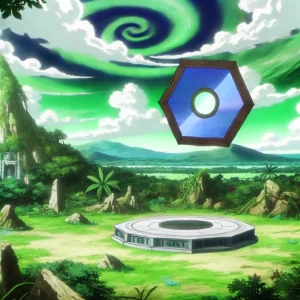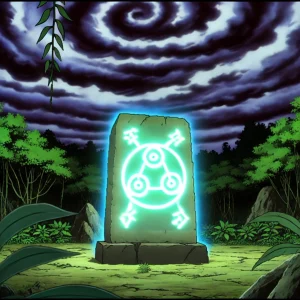Introduction

Hey there! Have you ever heard of "YU-NO: A Girl Who Chants Love at the Bound of this World"? If you're into anime or visual novels, this is a name you should definitely know. Let's dive into what makes this series so special, shall we?
So, "YU-NO" started off as a visual novel way back in the '90s. It's one of those classic tales that managed to capture the hearts and minds of many. The original game was known for its deep, intricate story and innovative gameplay that allowed players to explore multiple timelines and parallel worlds. Fast forward a few decades, and it got the anime treatment, bringing this beloved story to a whole new audience.
Now, what's the story about, you ask? The plot revolves around a young man named Takuya Arima. He receives a mysterious package from his supposedly deceased father, which contains a strange device and a letter hinting at the existence of parallel worlds. Intrigued and confused, Takuya sets off on an adventure to uncover the truth, traversing through different realities, each with its own secrets and challenges.
But it's not just the plot that's captivating. The characters in "YU-NO" are well-developed and relatable. You'll meet a diverse cast, including the enigmatic Kanna, the determined Mio, and the mysterious Eriko. Each character has a unique backstory and motivation, adding depth to the narrative and making the journey all the more engaging.
What really sets "YU-NO" apart, though, are the themes it explores. Love, destiny, and the concept of parallel universes are central to the story. It's fascinating to see how these themes are woven into the plot, making you ponder about the choices we make and the different paths our lives could take.
In the anime community, "YU-NO" has garnered quite a bit of attention. Fans appreciate its rich storytelling, complex characters, and thought-provoking themes. It's a series that sticks with you long after you've finished watching or playing. Plus, it’s sparked discussions and theories, adding to its popularity and importance.
Plot Summary

Hey, have you got a moment to talk about "YU-NO: A Girl Who Chants Love at the Bound of this World"? Trust me, this story is one wild ride! Let me give you a quick rundown of the plot and some of the key events that make this series unforgettable.
The story kicks off with Takuya Arima, an ordinary high school student who’s still reeling from the recent loss of his father, a renowned historian. One day, Takuya receives a peculiar package from his supposedly deceased dad. Inside, he finds a letter and a strange device. The letter hints at the existence of parallel worlds and urges Takuya to uncover the truth.
Naturally, Takuya is both intrigued and bewildered. He soon discovers that the device, called the Reflector, allows him to travel between parallel worlds. It's a bit like having a remote control for reality. Cool, right? But it’s not all fun and games. Each world he visits is a piece of a larger puzzle, filled with its own mysteries and dangers.
Early on, Takuya realizes that his journey isn’t just about finding his father. He encounters various characters, each with their own story and connection to the larger mystery. For instance, there’s Kanna, a mysterious girl who seems to know more than she lets on. Then there’s Mio, a classmate who becomes an unexpected ally, and Eriko, a teacher with her own secrets.
As Takuya navigates these parallel worlds, he starts to uncover the truth about his father's research and the enigmatic island where all these strange events began. One of the key turning points is when Takuya learns about the Divine Emperor, an ancient figure connected to the Reflector’s power. This revelation adds a layer of depth and urgency to his quest.
The concept of parallel worlds in "YU-NO" is fascinating. Imagine being able to jump from one reality to another, each with slight or significant differences. It’s like exploring a tree with countless branches, each representing a different possibility or outcome. Takuya uses the Reflector to reset events and explore different paths, which helps him piece together the larger mystery.
But these parallel worlds aren’t just alternate versions of reality—they’re interconnected. Actions in one world can have ripple effects in another. This interconnectedness means Takuya must be careful with his choices. It’s a bit of a mind-bender, but it’s what makes the story so engaging.
Throughout his journey, Takuya’s resolve is tested. He faces dangers, makes allies, and uncovers truths that challenge his understanding of reality. The Reflector is both a tool and a burden, guiding him through a labyrinth of worlds where each decision can lead to new revelations or dead ends.
Main Characters

Hey there! Ready to meet the fascinating characters of "YU-NO: A Girl Who Chants Love at the Bound of this World"? Trust me, these characters are as intriguing as the plot itself. Let's start with our main guy, Takuya Arima.
So, Takuya Arima is your typical high school student—or at least he was until his world turned upside down. After his father's mysterious disappearance, Takuya receives a strange device that lets him travel between parallel worlds. Takuya is curious, determined, and sometimes a bit impulsive, but his heart is always in the right place. He’s driven by the desire to uncover the truth about his father and the secrets of the Reflector device. Throughout his journey, Takuya’s character evolves as he faces countless challenges and grows from a curious teenager into a resilient and resourceful hero.
Now, let’s talk about Kanna Hatano. She’s quite the enigma. From the moment she appears, you can tell she knows more than she’s letting on. Kanna is quiet, mysterious, and often appears out of nowhere, dropping hints that guide Takuya on his journey. Her connection to the parallel worlds and her own secretive background make her a key player in the unfolding mystery. Kanna’s presence adds an air of intrigue and suspense, making you constantly question her true intentions.
Next up is Mio Shimazu, one of Takuya’s classmates. Mio starts off as a skeptic, always questioning Takuya’s wild theories about parallel worlds. But as events unfold, she becomes one of his closest allies. Mio is smart, resourceful, and has a strong sense of justice. Her development from a doubting classmate to a steadfast friend highlights the series' themes of trust and friendship. Mio’s practical approach and analytical mind complement Takuya’s more adventurous spirit, creating a dynamic partnership.
And then there’s Eriko Takeda, a teacher at Takuya’s school with her own share of secrets. Eriko is calm, composed, and often seems to be a step ahead of everyone else. She plays a crucial role in guiding Takuya and providing him with vital information about the Reflector and the parallel worlds. Eriko’s mysterious aura and vast knowledge make her an indispensable character. Her backstory and motives are gradually revealed, adding depth to her character and the overall narrative.
These characters aren’t just sidekicks or plot devices; they’re integral to Takuya’s journey and the series' complex narrative. Each one has their own motivations, secrets, and growth arcs that enrich the story. Their interactions with Takuya and each other create a web of relationships that drive the plot forward and keep you invested in their fates.
Themes and Motifs

First off, let’s talk about love. Love is a central theme in "YU-NO," but it’s not just the romantic kind. The story explores love in various forms—familial love, friendship, and even the love of discovery. Takuya’s quest is driven by the love for his missing father. This bond propels him into the unknown, as he searches for answers and clings to the hope of reunion. Throughout his journey, he forms deep connections with the people he meets in the parallel worlds, showing how love can be a guiding force even in the most confusing times.
Now, onto destiny. "YU-NO" delves into the idea of fate and how our choices shape our paths. The Reflector device that Takuya uses to navigate parallel worlds symbolizes this concept. It allows him to see the different outcomes of his decisions, highlighting the intricate dance between free will and destiny. Each world Takuya visits represents a different thread in the tapestry of fate, making you ponder: are our destinies written, or do we have the power to change them? This theme is portrayed through Takuya’s constant struggle to find the right path, emphasizing the importance of our choices and their consequences.
Then there’s the mind-bending concept of parallel universes. This theme is the backbone of the series, providing a unique framework for the narrative. The idea that there are multiple realities, each branching out from different decisions, is both thrilling and philosophical. Takuya’s journey through these parallel worlds not only serves the plot but also symbolizes the complexity of life and the endless possibilities that lie ahead. The series uses the parallel worlds to explore "what if" scenarios, pushing characters and viewers to think beyond their current reality.
Symbolism plays a big role in "YU-NO." The Reflector, for example, is more than just a plot device. It symbolizes the power of knowledge and the quest for truth. Each time Takuya uses it, he gains insight into the mysteries surrounding him, reflecting the broader theme of discovery and enlightenment. Another recurring motif is the concept of the "Divine Emperor," which ties into the themes of power, control, and the quest for ultimate knowledge. This motif is a constant reminder of the larger forces at play and the idea that there is always something greater than ourselves guiding our journey.
Recurring motifs like the mysterious letters and ancient artifacts add layers to the story. These elements symbolize the connection between past and present, hinting at the timeless nature of the themes explored in the series. They serve as breadcrumbs, leading Takuya and the audience deeper into the mystery, and highlighting the series' intricate narrative structure.
Reception and Impact

First off, let’s dive into the critical reception of the anime adaptation. When "YU-NO" made the jump from visual novel to anime, it had some big shoes to fill. Critics were eager to see how the intricate, multi-layered story would translate to the screen. Overall, the adaptation received a mix of praise and critique. On the one hand, critics lauded the anime for its ambitious storytelling and faithful adaptation of key plot points. They appreciated how it captured the essence of the original visual novel, maintaining the complex narrative and emotional depth that fans loved. However, some critics pointed out pacing issues and felt that certain plot elements were rushed or condensed, which sometimes made the story harder to follow for newcomers.
Now, what about the audience? Fans of the original visual novel had high expectations, and many were pleased with the adaptation. They enjoyed seeing beloved characters and pivotal moments brought to life with vibrant animation and voice acting. The emotional beats and intricate plot twists kept long-time fans engaged and excited. However, audience reactions were also divided. New viewers, who hadn’t played the visual novel, sometimes found the plot convoluted and hard to keep up with. Despite this, many appreciated the unique premise and were drawn into Takuya’s journey through parallel worlds.
Audience reviews highlight these mixed feelings. On platforms like MyAnimeList and Crunchyroll, you’ll find a spectrum of opinions. Some viewers praise the anime for its compelling story and deep themes, while others critique it for being too complex or slow-paced. It’s clear that "YU-NO" strikes a chord with those who appreciate intricate storytelling and philosophical themes, even if it’s not for everyone.
But let’s talk about the bigger picture: the influence and legacy of "YU-NO" in the anime genre. The original visual novel is considered a pioneer in its field, introducing many to the concept of branching narratives and parallel worlds. Its impact on the genre is significant, influencing later works that explore similar themes. The anime adaptation, despite its mixed reception, helped bring this classic story to a new generation, ensuring its legacy endures.
Moreover, "YU-NO" has inspired other creators. Its narrative complexity and thematic depth have set a standard for storytelling in anime and visual novels. You can see its influence in series that tackle parallel universes, time travel, and philosophical questions about destiny and choice. The innovative use of the Reflector device and the exploration of multiple realities have left a lasting mark on how such themes are approached in anime.
In essence, "YU-NO: A Girl Who Chants Love at the Bound of this World" continues to be a touchstone for both fans and creators. It’s a series that sparks discussions and inspires new stories, cementing its place in the annals of anime history. Whether you’re a long-time fan or a curious newcomer, its impact is undeniable and worth exploring.
